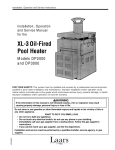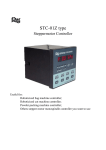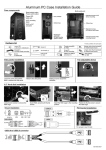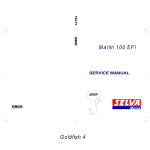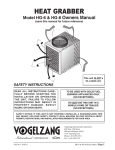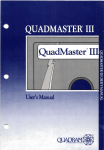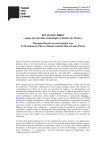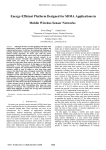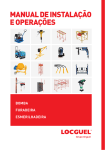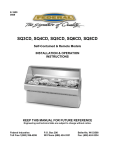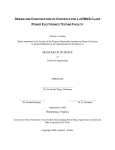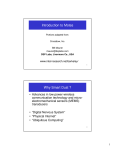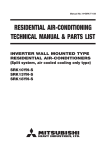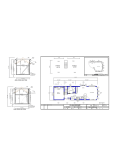Download A Testbed for Experiments with Sensor/Actuator Networks
Transcript
A Testbed for Experiments with Sensor/Actuator Networks Mohammed Rahimi Rohit Mediratta Karthik Dantu Gaurav S. Sukhatme Robotic Embedded Systems Laboratory Computer Science Department University of Southern California Los Angeles, CA 90089-0781, USA mhr mediratt dantu gaurav @.usc.edu Abstract We describe a table-top testbed for experiments in mobile sensor networks. The testbed includes static nodes as well as robotic mobile nodes. The static beacon nodes are used for localization and multihop network setup. The static snooper nodes serve the purpose of debugging and visualizing the experiment at a later time. The snoopers passively listen to packets. Ground truth is provided by an overhead vision system, and the data logged by the snoopers are replayed to evaluate/debug the network using NAM. Keywords: sensor network, sensor/actuator network, testbed 1 Introduction We describe the design of a planar testbed (Figure 1) for experiments with sensor/actuator networks on the benchtop. The testbed allows experimenters to populate the benchtop with small (upto 25 nodes) multi-hop wireless networks (typically upto 3 hops) of extreme embedded devices [1]. In addition, we have roboticized some of the sensor nodes such that they can move about on the testbed and autonomously re-position themselves [2]. An overhead camera system [3] provides ground truth for localization, and a set of snooper nodes capture network traffic for offline analysis. Since the setup is indoors we can easily control the illumination intensity (for experiments with the light sensors on the nodes), the locations of the nodes, camera calibration, and the like. The testbed is logically partitioned into a structured grid of 32 squares, with each square being 1 square foot in area. We describe the testbed setup in the following four sections. Beacons: the beacons are evenly distributed in the environment and know their x,y coordinates. These beacon nodes are used for localization as well as for multihop network setup. Snoopers: these nodes serve the purpose of debugging and visualizing the experiment at a later time. The snoopers passively listen to packets. Overhead vision: ground truth is provided by the vision system using mezzanine, an overhead camera system looking down onto the testbed. Post Processing: the data logged by the snoopers are replayed to evaluate/debug the network using NAM. The testbed (Figure 1) is a 8’x 4’ tabletop bound by a wooden fence 3/4” high. The tabletop is colored white to aid the ground truth system in identifying the robots based on color coding. The tabletop stands on top of three columns 40” high. 2 Beacons The beacons are built around the UC Berkeley Rene mote [1]. The beacons are evenly spread over the testbed and serve to make up the static part of the network. Each beacon has one Atmega 163L microcontroller based mote, one Programming board and a Nickel-coated Cover for RF shielding to minimize interference and multi-path effects. To ensure similar power levels for all beacons in the network we provide power using a 3V 500mA DC adapter. The beacons are programmed using Tiny OS [4]; a component-based small operating system. Each beacon executes a routing component as well as a localization component. 2.1 P ROGRAMMING B OARD The programming board 2 was fabricated specially to allow us to package it inside a case to minimize RF interference. The programming board is similar to the programming board from Berkeley, and differs only in the physical layout. As shown in 2 the programming board contains a DB25 male connector for programming any mote on the board. It also contains a DB9 female connector to read data over the serial port which helps in debugging. The programming board was manufactured by Crossbow Technologies ??. Figure 1: The testbed. Company Crossbow Technologies MG Chemicals Antenna Factor Radioshack Gold Star Technologies Product Super Shield Conductive Coating 841-340g JJB Series Permanent 1/4 Wave 3vDC/500mA Regulated AC-to-DC Adapter 273-1756 RocketPort Multiport Serial PCI Octa card 95850-5 URL www.xbow.com www.mgchemicals.com www.antennafactor.com www.radioshack.com www.gstmc.com Phone 408-965-3300 800-201-8822 800-489-1634 800-THE-SHACK 800-567-2764 Figure 2: Manufacturer contacts Figure 4: The case. Figure 3: The programming board. 2.2 AT M EGA 163 MOTES The ATMEL Atmega 163 mote is a 4 Mhz low power microcontroller based mote. It contains a 16KB flash instruction memory, 512 bytes of SRAM, a 256 KB of EEPROM as secondary storage. There is also a RFM TR1000 radio for communication. More details and hardware description can be found at http://webs.cs.berkeley.edu/tos 2.3 C ASING The beacons are placed inside special cases 3 to minimize Radio Frequency (RF) interference. These cases have interfaces for programming the motes and for debugging over the serial connection. The casing also has a power jack, to enable us to maintain constant power levels using a DC power adapter. The case is essentially the outer cover of a DB25 to DB 9 converter available off the shelf from any electronics shop. Our programming board was designed with the casing already available to us. We had to drill holes in the casing to allow us to provide power to the programming board as well as to allow space for the antenna to stick out. To minimize RF interference and multi-path fading effects we coated our casing with conductive Nickel coating ??. This conducting coat absorbs small traces of RF thus greatly reducing multipath fading effects. One to two mil coating provides 40db-50db shielding across a frequency range of 5 to 1800 Mhz. Since the coating is electrically conducting, we painted the casing on the inside, to prevent any possibility of a short circuit. We purchased monopole antennae from Antenna Factor ??. The tiny JJB series of antenna is only 7mm in diameter and can be soldered directly onto the PCB. It allows us minimize directional effects of unevenly shaped monopole antennae. The antenna works for the 902-928Mhz frequency range. To maintain a homogeneous setup of calibrated static nodes, it is important to ensure that all nodes have the same power levels available to them at all times. It can be easily shown [6] that the communication capabilities of any mote is greatly hampered by reducing power levels. We power all our beacons with 3V 500mA regulated DC power adaptors purchased from Radioshack ??. 3 Snoopers Our testbed has snooper nodes which are placed at specific places to sniff the packets being exchanged on the testbed. Snoopers are used for debugging, localization service, (the vision system is used for localization ground truthing) as well as replaying the network packet exchanges at a later time using our NAM post processing tool. Each snooper executes the GENERIC BASE component [4] and has a serial cable connected to one of the port on an 8 port serial card on a central machine (a PC next to the testbed). The serial card is polled on this machine to generate a dump (log) of almost all packets exchanged on the testbed. We ensure that packets, which may be read by multiple snoopers simultaneously, do not get logged multiple times. To undertake duplicate suppression we maintain a log of upto the last ten packets that were logged. Whenever a new packet is being logged into the log file, it is first checked against the last ten packets to ascertain that the packet was not already logged by some other snooper. The snooping system is thus composed of Programming boards Atmel 8535 motes Comtrol Rocketport 8 port serial card. Serial Extension cables. 3.1 P ROGRAMMING BOARDS The programming board contains a DB25 male connector for programming any mote on the board. It also contains a UART chip and a DB9 female connector to read data over the serial port which helps in debugging. The programming board was manufactured by Crossbow Technologies ??. 3.2 ATMEL 8535 MOTES The ATMEL 8535 mote is a 4 mhz low power microcontroller based mote. It contains a 8KB flash instruction memory, 512 bytes of SRAM, a 512 bytes of EEPROM as secondary storage. There is also a RFM TR1000 radio for communication for upto 10kbps data rate. More details and hardware description can be found at http://webs.cs.berkeley.edu/tos 3.3 C OMTROL ROCKETPORT 8 PORT PCI SERIAL CARD The card uses a 36Mhz ASIC (Application Specific Integrated Circuit) that enables the RocketPort ?? to transmit and receive data at rates up to 921 Kbps full duplex across all ports simultaneously. It provides us with 8 ports to which the snoopers communicate, to send the data they snoop. The data from all ports are timestamped and logged into the same log file. 3.4 S ERIAL E XTENSION CABLES The serial extension cables are used to connect the DB9 serial interface on the programming boards to the serial DB9 interface on the Y cable of the Rocketport PCI serial card. 4 Vision System The vision system is used as ground truth for the localization component executing on the Robomote. The vision system returns accurate x,y coordinates as well as orientation of the robots. We used Mezzanine1 [3] for our vision system. The system is freely available at playerstage.sourceforge.net Our camera is placed directly over the testbed. A wide angled camera provides us with a warped picture of the testbed, however Mezzanine is equipped with a dewarping utility to remove any dewarping effects. 4.1 C AMERA We used a regular off the shelf webcam with a wide angled lens. The camera was mounted on the roof, 6’ above the testbed, looking down on the testbed. It was attached to the roof using Velcro. This setup is prone to aging (camera angle looking down will change over time) but Mezzanine provides an easy GUI based calibration tool which override any loss of calibration due to movement of either the testbed or the camera. The camera provides an output in YUV space in the NTSC format onto the composite signal pin of the frame grabber. The camera is powered by a 5V 1000mA DC adaptor. 4.2 F RAME G RABBER We use a 640x480 interlaced NTSC PCI framegrabber. The camera’s output serves as a composite input for the framegrabber. The framegrabber captures 30 frames per second. However we use only 1 in 3 frames for an acceptable user interface display. The frame grabber is queried by Mezannine which processes the captured frames. 5 Post Processing The timestamped log file obtained by the snoopers is used for network replay, debugging and for analysis. The log file is converted from the raw packet format to a format acceptable to the Network Animator [7]. The post processor assumes that prior knowledge of the layout of the testbed is known and available in an options file. Since we had the liberty to manipulate the packet payload, we transmitted each packet with a pre-defined data structure, such that source, destination and present coordinate information was contained in each packet. This information was obtained from the log file and replayed by converting it into NAM format. The post processor is responsible for displaying to the user the packet exchange that took place when an experiment was being conducted. The post processor has an options file which is used for initializing the Network Animator input file, for specifying the size of the testbed and for specifying the scaling factor from testbed space to NAM space (they use different units). Every node’s (beacon and robomote) TOS LOCAL ADDRESS is required in the options file or else that node’s packets will be ignored by the post processor. The post processor itself has the option of specifying whether the user would like to follow the path that each robot followed during the experiment or whether just the current position at any time is required. 6 Localization A very simple RF-localization scheme has been implemented on the testbed using the beacon nodes placed two feet apart. The transmit power levels of the beacon nodes have been fine tuned to perform optimal triangulation [5]. A query packet is sent from either a mobile robot node or a stationary node. The beacons reply to this query (if they hear it) reporting their coordinates. The querying node localizes itself to the centroid of the location values of the replies it receives. The software on the beacon nodes has been modified so that their transmit power can be automatically tuned. We are in the process of incorporating signal-strength based weighting of the beacons received to provide a better location estimate [6]. Figure 5: The view from the overhead camera Acknowledgment This work is supported in part by ONR grant N0001400-1-0638 under the DURIP program and by NSF grants IIS-0133947 and ANI-0082498. References [1] David E. Culler, Jason Hill, Philip Buonadonna, Robert Szewczyk, and Alec Woo. A Network-Centric Approach to Embedded Software for Tiny Devices EMSOFT 2001 [2] Sibley, G.T., Rahimi, M.H. and Sukhatme, G.S. Robomote:A Tiny Mobile Robot Platform for LargeScale Sensor Networks 2002 IEEE International Conference on Robotics and Automation, pp. 11431148 [3] Andrew Howard Mezzanine User Manual; Version 0.00 IRIS-01-416, University of Southern California, 2002 [4] Jason Hill, Robert Szewczyk, Alec Woo, Seth Hollar, David E. Culler and Kristofer S. J. Pister System Architecture Directions for Networked Sensors, pp. 93-104, ASPLOS 2000 [5] Nirupama Bulusu, John Heidemann and Deborah Estrin In Proceedings of the 21st International Conference on Distributed Computing Systems (ICDCS21), Phoenix, Arizona, USA. April 16-19 2001. [6] Scott Klemmer, Sarah Waterson and Kamin Whitehouse Towards a Location-Based ContextAware Sensor Infrastructure CS Division, EECS Department, University of California at Berkeley http://guir.berkeley.edu/projects/location/Location.pdf [7] The Network Simulator http://www.isi.edu/nsnam at USC/ISI Figure 6: A screenshot of the mezzanine tool. Figure 7: A screenshot of the post processing using NAM







